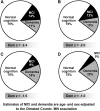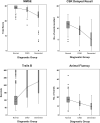Operationalizing diagnostic criteria for Alzheimer's disease and other age-related cognitive impairment-Part 2
- PMID: 21255742
- PMCID: PMC3039838
- DOI: 10.1016/j.jalz.2010.12.002
Operationalizing diagnostic criteria for Alzheimer's disease and other age-related cognitive impairment-Part 2
Abstract
This article focuses on the effects of operational differences in case ascertainment on estimates of prevalence and incidence of cognitive impairment and/or dementia of the Alzheimer type. Experience and insights are discussed by investigators from the Framingham Heart Study, the East Boston Senior Health Project, the Chicago Health and Aging Project, the Mayo Clinic Study of Aging, the Baltimore Longitudinal Study of Aging, and the Aging, Demographics, and Memory Study. There is a general consensus that the single most important factor determining prevalence estimates of Alzheimer's disease (AD) is the severity of cognitive impairment used as a threshold to define cases. Studies that require a level of cognitive impairment in which persons are unable to provide self-care will have much lower estimates than the studies aimed at identifying persons in the earliest stages of AD. There are limited autopsy data from the aforementioned epidemiological studies to address accuracy in the diagnosis of etiological subtype, namely the specification of AD alone or in combination with other types of pathology. However, other community-based cohort studies show that many persons with mild cognitive impairment and also some persons without dementia or mild cognitive impairment meet pathological criteria for AD, thereby suggesting that the number of persons who would benefit from an effective secondary prevention intervention is probably higher than the published prevalence estimates. Improved accuracy in the clinical diagnosis of AD is anticipated with the addition of molecular and structural biomarkers in the next generation of epidemiological studies.
Copyright © 2011 The Alzheimer's Association. Published by Elsevier Inc. All rights reserved.
Figures







References
-
- Dawber TR, Kannel WB. The Framingham study. An epidemiological approach to coronary heart disease. Circulation. 1966;34:553–5. - PubMed
-
- Farmer ME, White LR, Kittner SJ, Kaplan E, Moes E, McNamara P, et al. Neuropsychological test performance in Framingham: a descriptive study. Psychol Rep. 1987;60:1023–40. - PubMed
-
- Folstein MF, Folstein SE, McHugh PR. “Mini-mental state”. A practical method for grading the cognitive state of patients for the clinician. J Psychiatr Res. 1975;12:189–98. - PubMed
-
- Feinleib M, Kannel WB, Garrison RJ, McNamara PM, Castelli WP. The Framingham Offspring Study. Design and preliminary data. Prev Med. 1975;4:518–25. - PubMed
Publication types
MeSH terms
Grants and funding
- P50 AG016574/AG/NIA NIH HHS/United States
- P01AG012435/AG/NIA NIH HHS/United States
- R01NS17950/NS/NINDS NIH HHS/United States
- R01AG08122/AG/NIA NIH HHS/United States
- N01 AG012106/AG/NIA NIH HHS/United States
- R01AG033040/AG/NIA NIH HHS/United States
- R01AG021055/AG/NIA NIH HHS/United States
- R01AG033193/AG/NIA NIH HHS/United States
- R01AG011101/AG/NIA NIH HHS/United States
- U01 AG006786/AG/NIA NIH HHS/United States
- R01 AG031287/AG/NIA NIH HHS/United States
- R01 NS017950/NS/NINDS NIH HHS/United States
- R01 AG021055/AG/NIA NIH HHS/United States
- N01AG02107/AG/NIA NIH HHS/United States
- P50 AG005142/AG/NIA NIH HHS/United States
- R01AG16495/AG/NIA NIH HHS/United States
- R01 AG016495/AG/NIA NIH HHS/United States
- R01 AG034676/AG/NIA NIH HHS/United States
- U01 AG009740/AG/NIA NIH HHS/United States
- U01AG06786/AG/NIA NIH HHS/United States
- P50AG016574/AG/NIA NIH HHS/United States
- R01AG008325/AG/NIA NIH HHS/United States
- R01 AG008122/AG/NIA NIH HHS/United States
- P01 AG012435/AG/NIA NIH HHS/United States
- N01 HC025195/HL/NHLBI NIH HHS/United States
- R01 AG033193/AG/NIA NIH HHS/United States
- U01AG009740/AG/NIA NIH HHS/United States
- R01 AG033040/AG/NIA NIH HHS/United States
- R01 AG011101/AG/NIA NIH HHS/United States
- R01AG034676/AG/NIA NIH HHS/United States
- R01AG031287/AG/NIA NIH HHS/United States
- P50AG005142/AG/NIA NIH HHS/United States

